PSY 1.6 Identity and Personality
1/91
There's no tags or description
Looks like no tags are added yet.
Name | Mastery | Learn | Test | Matching | Spaced |
|---|
No study sessions yet.
92 Terms
self concept
is the sum of the ways in which we describe ourselves: in the present, who we used to be, and who we might be in the future.
self schema
ways in which we define ourselves fall under the classification
label
identities
are individual components of our self-concept related to the groups to which we belong.
Eg Religious affiliation, sexual orientation, and ethnic and national affiliations are examples of identities.
gender identity
people’s appraisals of themselves on scales of masculinity and femininity.
androgyny
defined as the state of being simultaneously very masculine and very feminine
undifferentiated
achieve low scores on both scales of masculinity and femininity
ethnic identity
part of one’s identity associated with membership in a particular racial/ethnic group
nationality
identity based on political borders
shared history, media, cuisine, and national symbols such as a country’s flag
hierarchy of salience
Refers to the likelihood that a particular identity will be active or relevant across different situation
self discrepancy theory
maintains that each of us has three selves and that perceived differences between these selves lead to negative feelings.
self-concept
ideal self
ought self
self concept
actual self
ideal self
the person we would like to be
ought self
our representation of the way others think we should be
self esteem
describes our evaluation of ourselves.
Generally, the closer our actual self is to our ideal self (who we want to be) and our ought self (who others want us to be), the higher our self-esteem will be.
self efficacy
is our belief in our ability to succeed
is the degree to which we see ourselves as being capable at a given skill or in a given situation.
When placed in a consistently hopeless scenario, self- efficacy can be diminished to the point where learned helplessness results.
overconfidence
can lead us to take on tasks for which we are not ready, leading to frustration, humiliation, or sometimes even personal injury.
locus of control
is a self-evaluation that refers to the way we characterize the influences in our lives.
People with an internal locus of control see their successes and failures as a result of their own characteristics and actions, while those with an
external locus of control perceive outside factors as having more of an influence in their lives.
attribution theory
makes links to locus on control and cognitive dissonance

Freud’s psychosexual stages of personality development
based on the tensions caused by the libido (sex drive). Failure at any given stage leads to fixation that causes personality disorders.
Freud’s phases (oral, anal, phallic [Oedipal], latent, and genital) are based on the erogenous zones that are the focus of each phase of development.
fixation
occurs when a child is overindulged or overly frustrated during a stage of development
neurosis
mental disorder stemming from repressed emotions and conflicts, often manifesting as anxiety, worry, or other behavioral or psychosomatic symptom
The core of neurosis lies in unresolved conflicts between the unconscious mind (id) and the conscious mind (ego
[freud] Oral Stage
0-1 years old
During this stage, gratification is obtained primarily through putting objects into the mouth, biting, and sucking. Libidinal energy is centered on the mouth. An adult who is orally fixated would be expected to exhibit excessive dependency.
[freud] anal stage
from 1 to 3 years, during which the libido is centered on the anus and gratification is gained through the elimination and retention of waste materials. Toilet training occurs during this stage. Fixation during this stage would lead to either excessive orderliness (anal-retentiveness) or sloppiness in the adult.
[freud] phallic / oedipal stage
Oedipal conflict for male children or the analogous
Electra conflict for female children.
latency stage
which lasts until puberty is reached.
genital stage
beginning in puberty and lasting through adulthood. According to Freud, if prior development has proceeded correctly, the person should enter into healthy heterosexual relationships at this point.
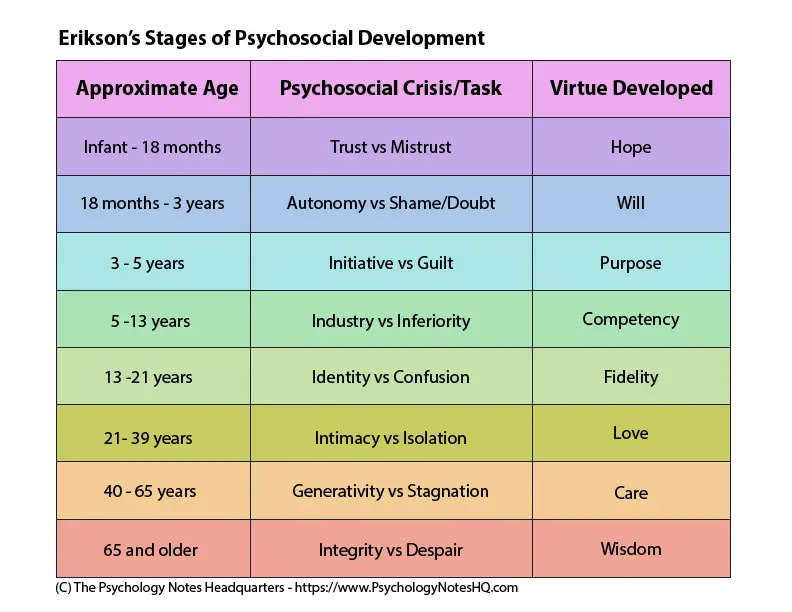
Erikson’s stages of psychosocial development
stem from conflicts that occur throughout life
personality development is driven by the successful resolution of a series of social and emotional conflicts
These conflicts are the result of decisions we are forced to make about ourselves and the environment around us at each phase of our lives.
trust vs mistrust
arise because an individual lacks some critical social or emotional skill.
autonomy vs shame
1-3 years
where children begin to explore their surroundings and develop their interests.
initiative vs guilt
3-6 years
children learn basic cause and effect
industry vs inferiority
6-12 years
here pre-adolescents are becoming aware of themselves as individuals.
identity vs role confusion
adolescents explore their independence to determine who they are and what their purpose is in society.
intimacy vs isolation
20-40 years
where people focus on creating long-lasting bonds with others.
generativity vs stagnation
40-65 years
where the focus is on advancing present and future society. The successful resolution of this conflict results in an individual capable of being a productive, caring, and contributing member of society.
integrity vs despair
above 65 years
where the focus tends to be reflective and contemplative.

Kohlberg’s stages of moral development
describe the approaches of individuals to resolving moral dilemmas. Kohlberg believed that we progress through six stages divided into three main phases: preconventional, conventional, and postconventional.
viewed these stages as a progression in which each stage is adopted and then abandoned for the next as the individual progresses.
preconventional morality
places an emphasis on the consequences of the moral choice.
Stage one (obedience) is concerned with avoiding punishment (If I steal the drug, I’ll go to jail)
stage two (self-interest)/ instrumental relativist is about gaining reward
conventional morality
begins to develop in early adolescence when individuals begin to see themselves in terms of their relationships to others. This phase is based on understanding and accepting social rules.
Stage three (conformity) places emphasis on the “nice person” orientation in which an individual seeks the approval of others (I should not steal the drug because stealing is wrong).
Stage four (law and order) maintains the social order in the highest regard (If everyone stole things they couldn’t afford, people who produce those items would not be able to continue their business).
postconventional morality
which describes a level of reasoning that Kohlberg claimed not everyone was capable of and is based on social mores, which may conflict with laws.
Stage five (social contract) views moral rules as conventions that are designed to ensure the greater good, with reasoning focused on individual rights (Everyone has a right to live; businesses have a right to profit from their products)
stage six (universal human ethics) reasons that decisions should be made in consideration of abstract principles (It is wrong for one person to hold another’s life for ransom).
Vygotsky
described development of language, culture, and skills.
He proposed the idea of the zone of proximal development, which describes those skills that a child has not yet mastered and require a more knowledgeable other to accomplish.
Imitation and role-taking
are common ways children learn from others. Children first reproduce the behaviors of role models, and later learn to see the perspectives of others and practice taking on new roles.
theory of mind
The ability to sense how another’s mind works—for example, understanding how a friend is interpreting a story while you tell it
we begin to recognize and react to how others think about us. We become aware of judgments from the outside world and react to these judgments. Our reactions to how others perceive us can be varied—maintaining, modifying, downplaying, or accentuating different aspects of our personality
reference group
the group to which we compare ourselves. Two individuals with the same qualities might see themselves differently depending on how those qualities compare to their reference groups.
psychoanalytic perspective
views personality as resulting from unconscious urges and desires.
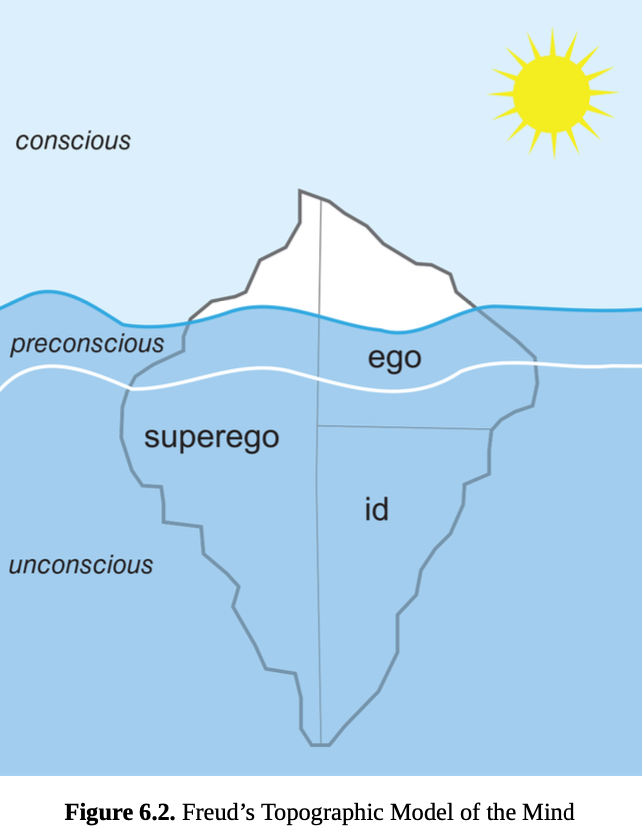
id
pleasure principle
base urges of survival and reproduction
wish fulfilment
Mental imagery, such as daydreaming or fantasy, that fulfills this need for satisfaction
superego
the idealist and perfectionist
judging our actions and responding with pride at our accomplishments and guilt at our failures
can be divided two subsystems
conscience (collection of the improper actions for which a child is punished)
ego-ideal (consists of those proper actions for which a child is rewarded)
ego
mediator
reality principle
ego makes use of defense mechanisms to reduce stress caused by the urges of the id and the superego.
instinct
an innate psychological representation of a biological need. Instincts are the propelling aspects of Freud’s dynamic theory of personality
2 types:
life (Eros individual’s quest for survival through thirst hanger and sexual needs)
death (Thanatos unconscious wish for death and destruction)
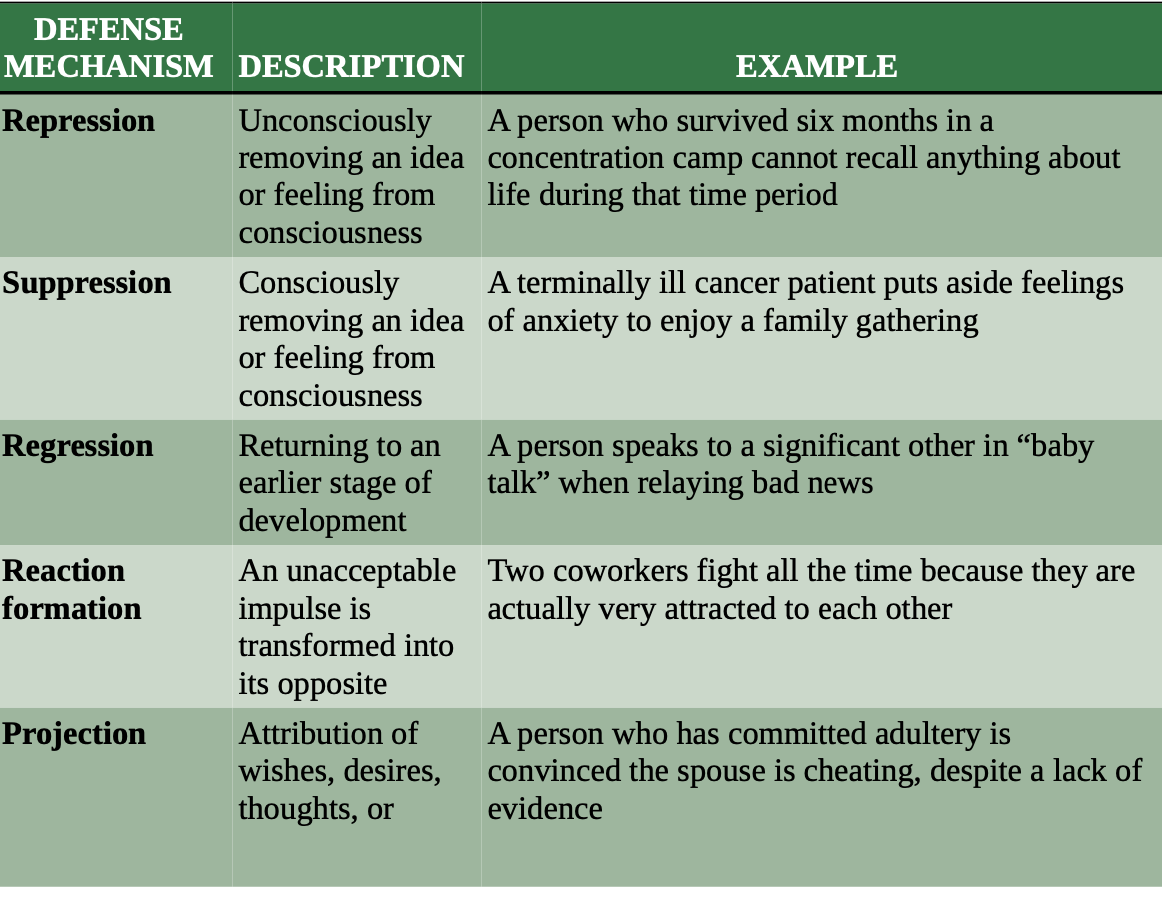
defense mechanism
ego’s recourse for relieving anxiety caused by the clash of the id and superego
wo common characteristics: first, they deny, falsify, or distort reality; second, they operate unconsciously.
There are 8 main defense mechanisms:
repression
suppression
regression
reaction formation
projection
rationalization
displacement
sublimation.
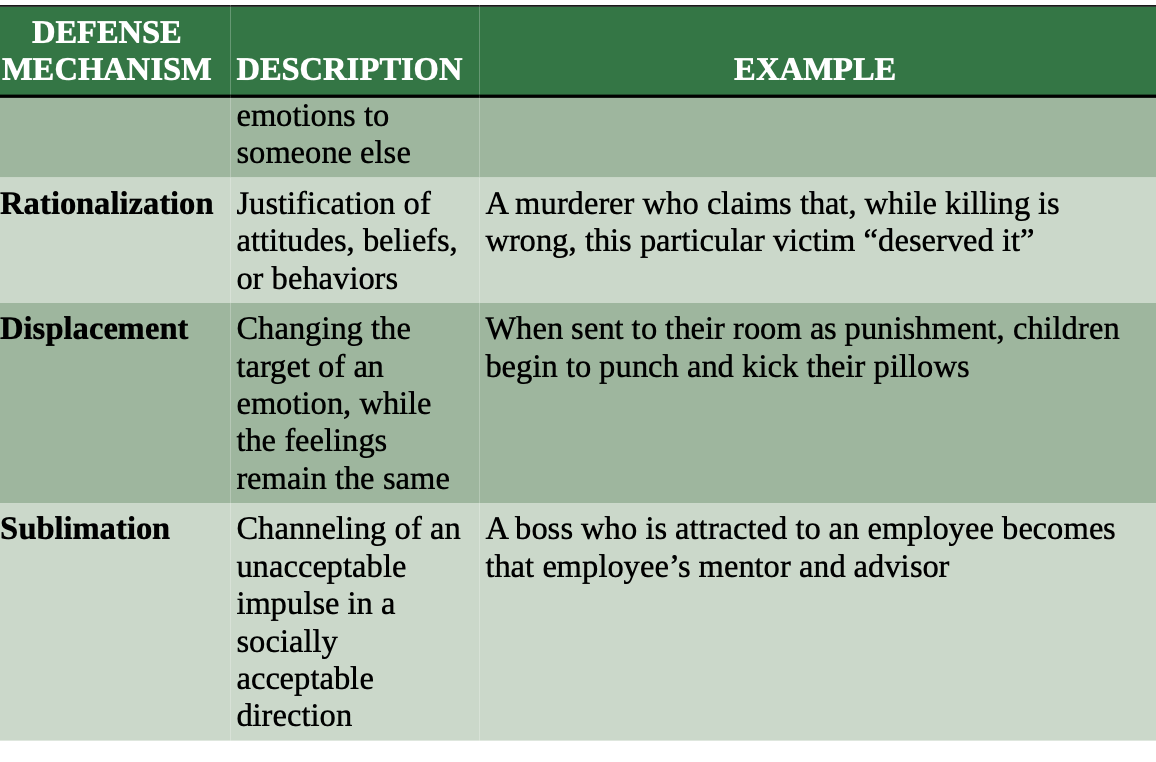
repression
ego’s way of forcing undesired thoughts and urges to the unconscious and underlies many of the other defense mechanisms, the aim of which is to disguise threatening impulses that may find their way back from the unconscious. While repression is mostly an unconscious forgetting, suppression is a more deliberate, conscious form of forgetting.
regression
reversion to an earlier developmental state. Faced with stress, older children may return to earlier behaviors such as thumb sucking, throwing temper tantrums, or clinging to their caregivers.
reaction formation
occurs when an individual suppresses urges by unconsciously converting these urges into their exact opposites. For example, a person pining after an inaccessible celebrity may outwardly express hatred for the celebrity as a way of reducing the stress caused by these unrequited feelings.
projection
individuals attribute their undesired feelings to others. I hate my parents might, for example, turn into My parents hate me. Projection is an important part of personality analysis.
rationalisation
justification of behaviors in a manner that is acceptable to the self and society. Drivers who engage in reckless feats such as the Cannonball Run (a cross- country race from Los Angeles to New York) might justify their dangerous pursuits by saying, both to themselves and others: I’m in complete control, and besides, there are plenty of dangerous drivers on the road. What difference will one more make?
displacement
describes the transference of an undesired urge from one person or object to another. Someone angry at a supervisor at work may remain quiet there but snap at a family member at home
sublimation
transformation of unacceptable urges into socially acceptable behaviors. Freud might say that pent-up sexual urges may be sublimated into a drive for business success or artistic creativity.
collective unconsciousness
Carl Jung
a shared, inherited reservoir of universal human experiences, instincts, and archetypes, distinct from personal unconsciousness, that are believed to be present in all individuals
persona
likened to a mask that we wear in public
personality we present to the world
anima (feminine)
suppressed female quality in males that explains emotional behavior (described by Jung as a man’s inner woman)
animus (masculine)
the animus is the analogous male quality of females that explains power-seeking behavior (a woman’s inner man).
shadow
responsible for the appearance of unpleasant and socially reprehensible thoughts, feelings, and actions experienced in the unconscious mind.
self
was the point of intersection between the collective unconscious, the personal unconscious, and the conscious mind. The self strives for unity.
inferior complex
Alfred Adler
an individual’s sense of incompleteness, imperfection, and inferiority both physically and socially.
creative self
is the force by which individuals shape their uniqueness and establish their personality.
style of life
represents the manifestation of the creative self and describes a person’s unique way of achieving superiority. The family environment is crucial in molding the person’s style of life
fictional finalism
notion that individuals are motivated more by their expectations of the future than by past experiences.
summed up by the phrase Life would be perfect if only...
object relations theory
object refers to the representation of caregivers based on subjective experiences during early infancy. These objects then persist into adulthood and impact our interactions with others, including the social bonds we create and our predictions of others’ behavior.
humanistic perspective
perspective emphasizes the internal feelings of healthy individuals as they strive toward happiness and self-realization
associated with Gestalt therapy > a holistic view of the self, seeing each individual as a complete person rather than reducing the person to individual behaviors or drives.
force field theory
Kurt Lewin
defined the field as one’s current state of mind, which was simply the sum of the forces (influences) on the individual at that time. If the focus of humanistic psychology is exploring how an individual reaches self-realization, then these forces could be divided into two large groups: those assisting in our attainment of goals and those blocking the path to them.
Maslow hierarchy of needs
and Rogers’s therapeutic approach of unconditional positive regard flow from the humanistic view of personality.
peak experiences
profound and deeply moving experiences in a person’s life that have important and lasting effects on the individual
personal construct psychology
psychotherapy is a process of insight whereby people acquire new constructs that will allow them to successfully predict troublesome events. Then, the individual will be able to integrate these new constructs into already existing ones.
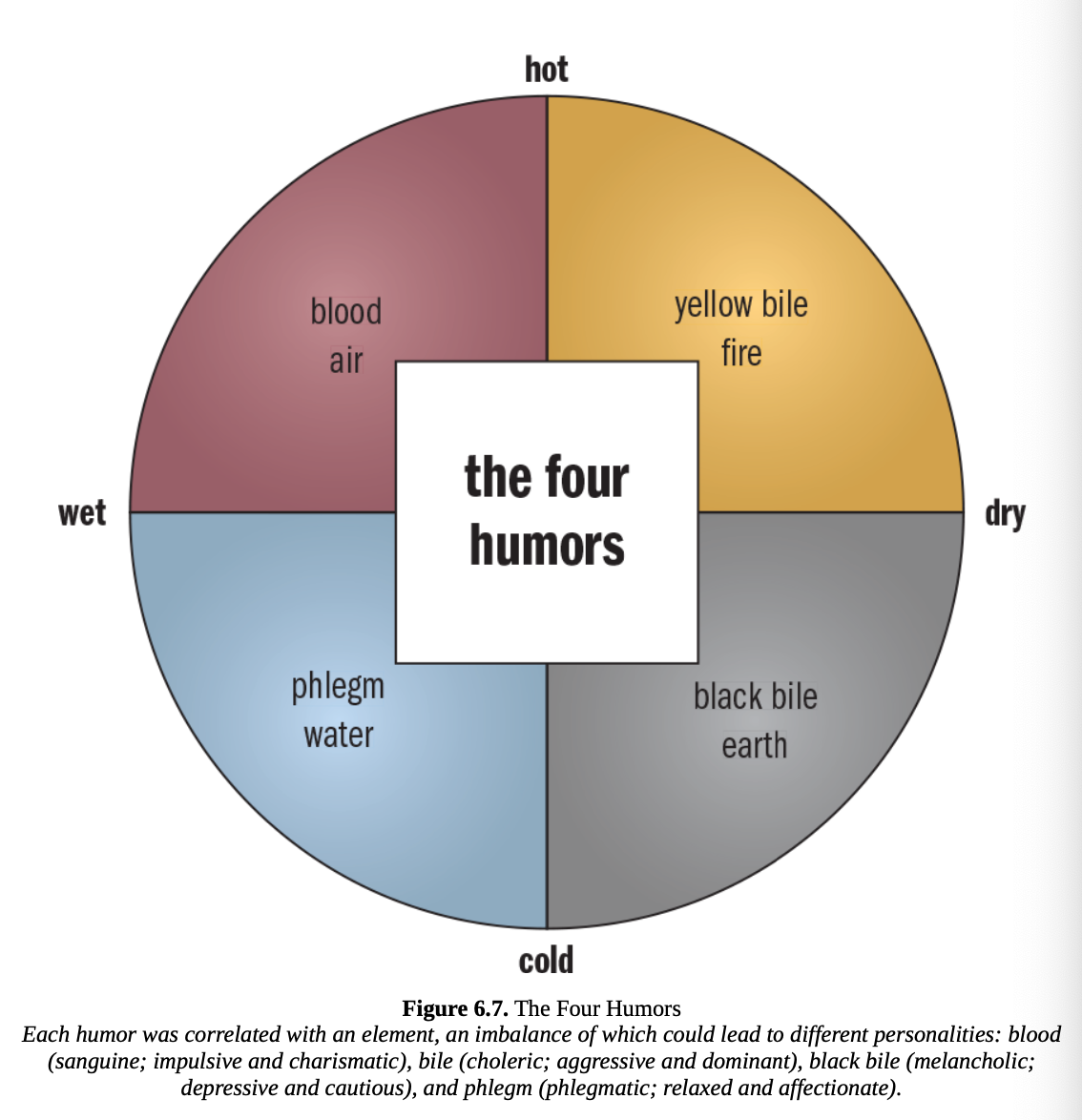
Type and trait
believe that personality can be described as a number of identifiable traits that carry characteristic behaviors.
Type theories of personality include the ancient Greek notion of humors, Sheldon’s somatotypes, division into Types A and B, and the Myers–Briggs Type Inventory.
somatotypes
categorize human body types into three main types:
endomorph (rounded, soft)
mesomorph (muscular, athletic)
ectomorph (thin, lean
Type A personality
characterized by behavior that tends to be competitive and compulsive
Type B personality
generally laid-back and relaxed
Big 5
OCEAN
openness, conscientiousness, extraversion, agreeableness, and neuroticism.
Extraversion
measure of tolerance for social interaction and stimulation
Neuroticism
is a measure of emotional arousal in stressful situations.
Psychoticism
a measure of nonconformity or social deviance
openness
describes openness to experience, or willingness to engage with the world and desire to try new things.
conscientiousness
some ways analogous to self control, with high conscientiousness associated with high impulse control and low conscientiousness associated with spontaneity
agreeableness
refers to the degree to which a person is concerned about maintaining peace and harmony in their interactions with others.
cardinal traits
around which people organize their lives; not everyone develops a cardinal trait.
are dominant personality traits that strongly influence a person's thoughts, feelings, and behaviours
eg Einstein’s intelligence
central trait
represent major characteristics of the personality
eg honesty or charisma
secondary trait
are more personal characteristics and are limited in occurrence.
functional autonomy
which a behavior continues despite satisfaction of the drive that
originally created the behavior. A hunter, for example, may have originally hunted to obtain food to eat. However, the hunter may continue even after there is enough food simply for the enjoyment of the hunt: that which began as a means to obtain a goal became the goal itself.
token economies
positive behavior is rewarded with tokens that can be exchanged for privileges, treats, or other reinforcers.
behaviourist perspective
BF Skinner
based on the concept of operant conditioning, holds that personality can be described as the behaviors one has learned from prior rewards and punishments.
social cognitive perspective
Albert Bandura
emphasizes the dynamic interaction between personal factors, behavior, and the environment, highlighting how individuals learn by observing others and actively shaping their own experiences
biological perspective
claim that behavior can be explained as a result of genetic expression.